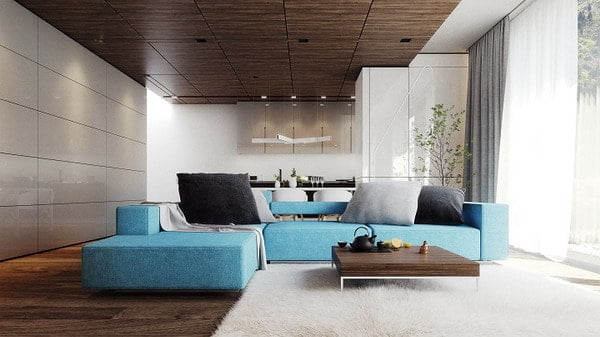 The architecture trends for 2024 and 2025 have one thing in common: the commitment to sustainable development and sustainable architecture. Society in general is evolving towards environmental commitment and architectural trends, as a social manifestation, too.
The architecture trends for 2024 and 2025 have one thing in common: the commitment to sustainable development and sustainable architecture. Society in general is evolving towards environmental commitment and architectural trends, as a social manifestation, too.
The use of recyclable materials, buildings that are self-sufficient and installations of all kinds that respect the planet are becoming more frequent. But there are more trends in architecture that we tell you below.
15 trends 2024-2025 that will mark the architecture styles of the future
Read carefully these proposals because they are here to stay, most of them, and will be a trend in architecture for a long time.
1. Industrial style in the housing architecture
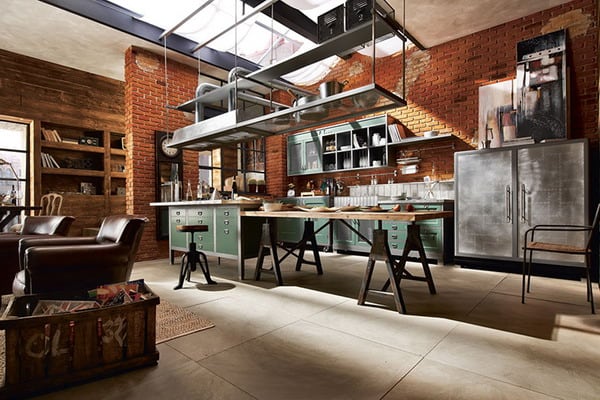 It is defined by asymmetrical forms in construction, both in residential buildings and in other urban infrastructures. It is characterized by the combination of iron, wood, aluminum and even recycled plastic, which means a reduction in construction costs. Simple lines and absence of surface elements are also characteristic of the industrial style.
It is defined by asymmetrical forms in construction, both in residential buildings and in other urban infrastructures. It is characterized by the combination of iron, wood, aluminum and even recycled plastic, which means a reduction in construction costs. Simple lines and absence of surface elements are also characteristic of the industrial style.
In the image we see an industrial style loft designed with tiles from the Brooklyn series by Azulev.
2. Home automation and smart homes
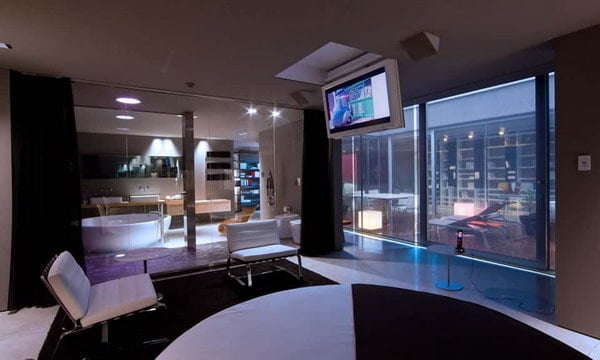 It is an upward trend, both for new buildings and for rehabilitated buildings. Automated systems are increasingly in demand to control the temperature, light or security of homes.
It is an upward trend, both for new buildings and for rehabilitated buildings. Automated systems are increasingly in demand to control the temperature, light or security of homes.
A smart building offers its users greater comfort and reduces consumption bills. Domotic architecture is a reflection of social awareness for the care of the environment and the need to consume the right.
3. Open and multipurpose spaces
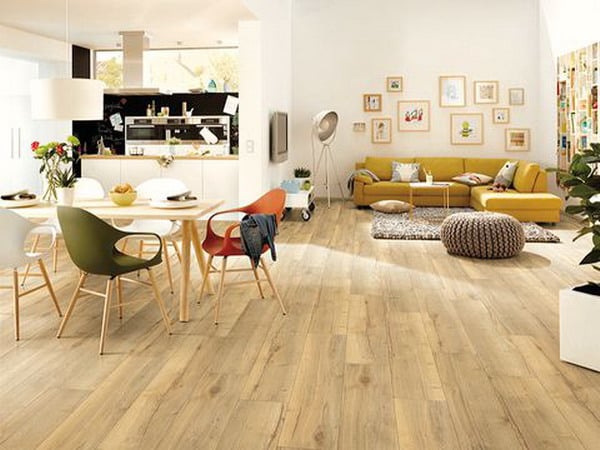 The commitment to integrate different areas of the home to create diaphanous and polyvalent environments is becoming clearer. This solution will allow you to enjoy more meters, what you gain from the partitioned walls, and very practical spaces for the whole family.
The commitment to integrate different areas of the home to create diaphanous and polyvalent environments is becoming clearer. This solution will allow you to enjoy more meters, what you gain from the partitioned walls, and very practical spaces for the whole family.
Use building materials that serve as a link between the rooms and decorate the entire room in a consistent way, to gain space and light.
The integration of the kitchen and the living room is the most common in the floors with a few meters. But you can also choose to join the living room with the terrace or the living room with the bedroom. In the market there are folding and retractable furniture that will help you in these cases so that you can pass from one to another naturally.
GOOD TO READ: New Home Construction Trends 2025
Heritage is a stone from the limestone family of our Azulev brand. This tile is ideal to unify interior or exterior spaces, as we see in the image above.
The new uses of traditional spaces were the subject of debate in the latest edition of SIMO, where Martha Torne and the architect Frida Escobedo discussed this topic. An irrefutable proof of how the concept of a room and architectural interest is changing to redefine spaces.
4. The kitchen is the new protagonist…
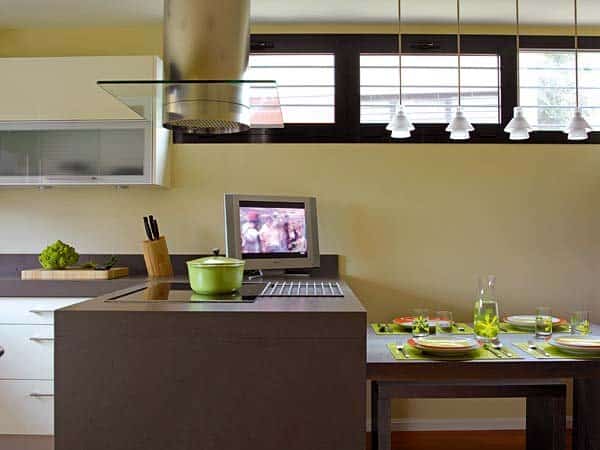 The kitchen has traditionally been the most lived stay in the house. In it we prepare food and, on many occasions, the family gathers to eat. But it is also the favourite place for children to play or for the guests to have an aperitif.
The kitchen has traditionally been the most lived stay in the house. In it we prepare food and, on many occasions, the family gathers to eat. But it is also the favourite place for children to play or for the guests to have an aperitif.
On this occasion, we have also used the Heritage series to create this kitchen environment.
That is why the trends in architecture for 2024 give prominence to the kitchen, increasing its dimensions and connecting it with the dining room and the living room. If you have that possibility, place a central island that serves as a water zone and a breakfast bar and that visually separates the lounge area.
5…. and the bathroom is a space for relaxation
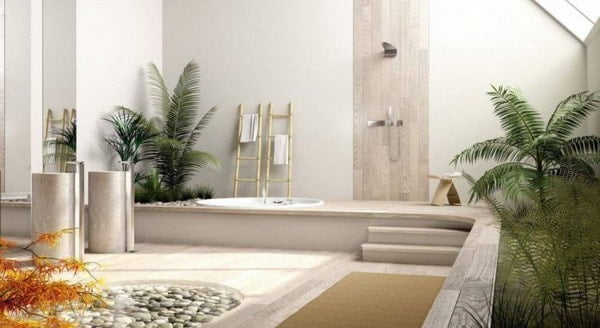 The bathroom is no longer, solely, the space dedicated to personal care. Now this stay is understood as the place to relax after a hard day’s work. Where to disconnect from the outside to reconnect with himself during a shower that will release our tensions. And all this thanks to the design and decoration.
The bathroom is no longer, solely, the space dedicated to personal care. Now this stay is understood as the place to relax after a hard day’s work. Where to disconnect from the outside to reconnect with himself during a shower that will release our tensions. And all this thanks to the design and decoration.
This magnificent bathroom is much more than a bathroom is a real spa that we can have in our home, to enjoy a time of relaxation and relaxation thanks to the sauna, whirlpool and hammocks where we can relax lying. This environment has been designed with our Calacatta and EternalOak series.
GOOD TO READ: New Trends In Hotel Architecture
The new trends in bathrooms opt for coatings in very light or white colors, with tiles that facilitate cleaning and transmit calm and serenity. The shower becomes the main protagonist of the bathroom, either a hydro massage cabin or a shower with screen. It is important that you have the necessary dimensions so that its use is comfortable for all users.
The simple furniture with storage capacity, to have it all collected, and an indoor plant will create the necessary atmosphere to enjoy the daily care.
6. Protagonism of floors and walls
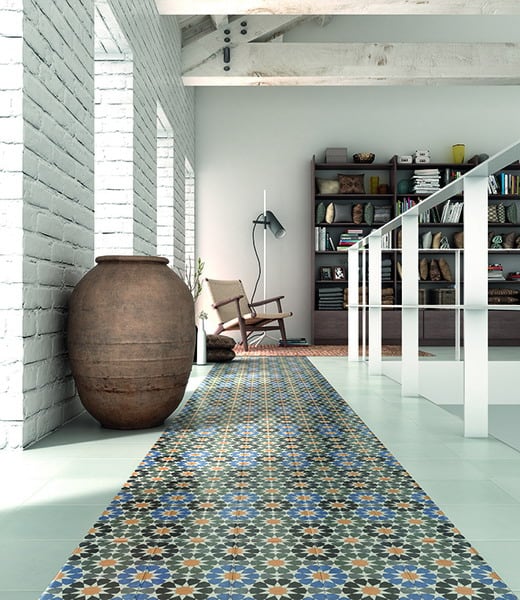 These decorative elements acquire a greater prominence in the architectural trends of 2024. The coverings with quality tiles that imitate different materials are imposed by their functionality.
These decorative elements acquire a greater prominence in the architectural trends of 2024. The coverings with quality tiles that imitate different materials are imposed by their functionality.
In the image above, we see an environment with floors and walls with our marble tiles of the Calacatta de Azulev series.
You can place coatings with a wide variety of textures and colors, imitating mud, wood or polished cement among other materials. Make sure you always buy products that are environmentally friendly in their manufacture.
7. Risky combinations
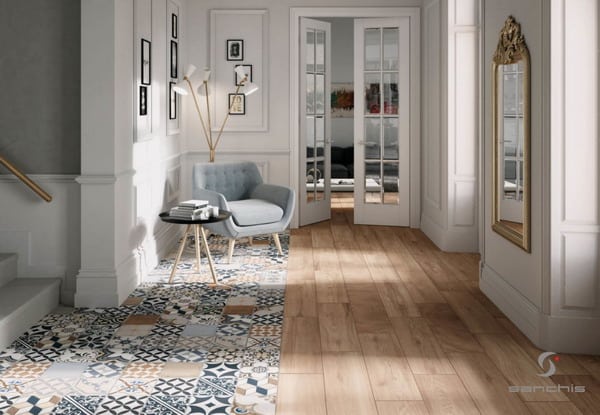 The market offers such a variety of styles and colors in all building materials that it is difficult to choose a single option. That is why in this year the spaces with a multitude of shapes and materials will be trends, combined properly.
The market offers such a variety of styles and colors in all building materials that it is difficult to choose a single option. That is why in this year the spaces with a multitude of shapes and materials will be trends, combined properly.
In the image above, we can see the spectacular result that the combination of the porcelain parquet of the Traditional Woods series by Combiwood and the hydraulic tiles of the Oldker series by Sanchis provide.
The yellow in its different tonalities; from the ancient rose to the red watermelon; tiles with textures that mimic corduroy or tweed.In short, an explosion of shapes and colors that will affect the construction and decoration of homes and work spaces to create spaces full of life.
8. White, always white
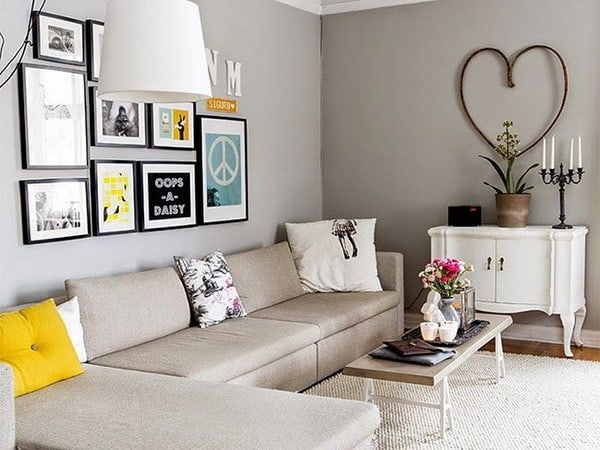 White in its different shades continues to be the protagonist in interior design, alone or combined with other colors such as black, mustard or gray. In the coatings of walls and floors it provides luminosity to the rooms and visually expands them.
White in its different shades continues to be the protagonist in interior design, alone or combined with other colors such as black, mustard or gray. In the coatings of walls and floors it provides luminosity to the rooms and visually expands them.
In addition, it reflects all the light received, so it is recommended in the case of dark or interior rooms. Used in its proper measure, for example, in bathroom tiles, white will provide an excellent aesthetic result.
9. Reform, rehabilitate, remodel
The principle of achieving the best results by minimizing the works is a trend during 2024. Rehabilitating old buildings, and historical in many cases, to give them a new usefulness is a process that we have been observing in our cities for several years.
Also the reform of the houses to adapt them to the new social demands and to endow them with greater comforts. These actions have the advantage of a lower economic cost than the construction from scratch of the house or building.
All the series of our line Slim Rect are especially indicated for the reforms and the rehabilitation of buildings, since they allow the over-tiling thanks to its thin thickness of 6mm. Likewise, XLAM brand of Azulev Group also offers extra-thin pavements, 6mm thick, which are ideal for renovations and renovations because they also allow over-tiling.
10. The new minimalism
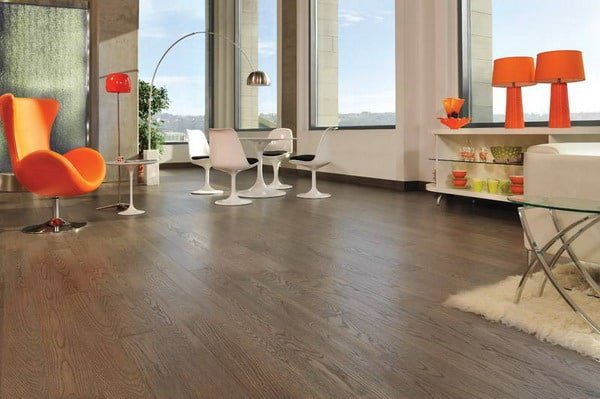 The trend towards minimalism in architecture translates into a commitment to simple forms using modern and avant-garde materials. Contract projects are highly demanded for homes and hotels, as well as for office buildings and shopping centers. It is a tendency to use quality materials to ensure thermal and acoustic insulation that will result in economic savings and an environmental benefit.
The trend towards minimalism in architecture translates into a commitment to simple forms using modern and avant-garde materials. Contract projects are highly demanded for homes and hotels, as well as for office buildings and shopping centers. It is a tendency to use quality materials to ensure thermal and acoustic insulation that will result in economic savings and an environmental benefit.
11. The contract concept
This innovative concept creates innovative working environments through open, transparent and transparent spaces. According to the new methodology at work, which advocates collaboration and teamwork, offices are conceived as constantly changing spaces that can be adapted at any time to the needs of users.
The contract concept is transferred to the houses to create multifunctional spaces without partition walls between some rooms and with rooms limited by glass walls.
12. Enjoy the outdoors all year
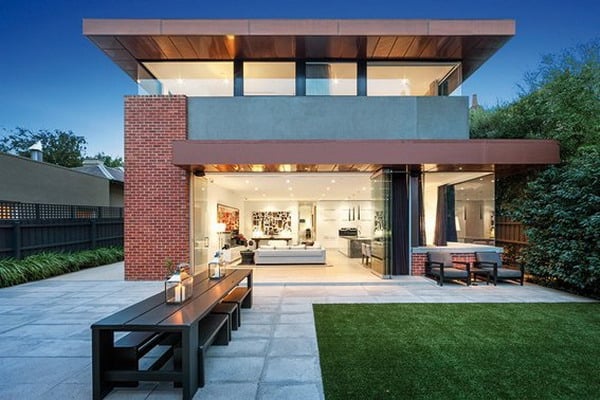 The terraces and balconies can be enjoyed throughout the year if you condition them properly. They are a trend in architecture glass enclosures without profiles, so-called glass curtains, which allow you to open the space fully when the good weather arrives. If you have an outdoor space, however small, you can place mobile stoves to combat the cold.
The terraces and balconies can be enjoyed throughout the year if you condition them properly. They are a trend in architecture glass enclosures without profiles, so-called glass curtains, which allow you to open the space fully when the good weather arrives. If you have an outdoor space, however small, you can place mobile stoves to combat the cold.
The Brooklyn series by Azulev, among others of our brand, with anti-slip finish, ideal for all types of exteriors.
Brooklyn is a contemporary material that fuses cement, stone and cotto. Its minimalist essence makes it an ideal tile for modern or industrial style rooms, which can be placed both indoors and outdoors. This series can be found in the following formats: 100×100, 50×100, 75×150, 75×75, 59×59, 29×59 and 75×75 with 20mm thickness.
13. Less noise, more light
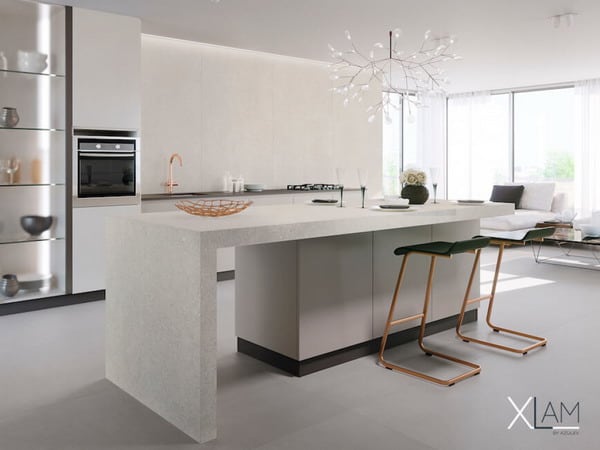 Noise is a pollutant to which we are exposed inside and outside our homes. That is why more and more architectural projects are carried out with this annoyance in mind, using distributions and materials that minimize noise inside the buildings.
Noise is a pollutant to which we are exposed inside and outside our homes. That is why more and more architectural projects are carried out with this annoyance in mind, using distributions and materials that minimize noise inside the buildings.
At the same time,architectural technology is developed so that buildings take advantage of the natural light they receive from the sun. And, at the same time, there are trends that integrate artificial lighting in the most natural way possible, either with foci stolen between the furniture or in the form of indirect warm light.
14. Tests with novel constructive methods
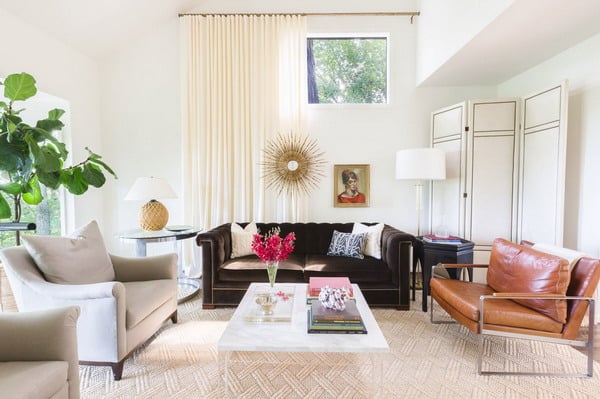 During the year 2024 we will know some of the results of the experimentation with new construction systems.
During the year 2024 we will know some of the results of the experimentation with new construction systems.
Environment created with a floor designed with the Genuine series by Azulev, which is a wooden porcelain tile, and a special lining for the fireplace, for which the Expression series of our large format XLAM brand has been used. The Expression collection is a very thin type of tin and iron plate.
Genuine is a special wooden porcelain designed to design rooms with an elegant and unique style.
Structures made of recycled materials, such as plastic, or traditional construction methods will be implemented to curb environmental destruction and fight against climate change. An example of this trend can be found in the Kräuterzentrum de Ricola, designed byHerzog & de Meuron, winners of the 2001 Pritzker Prize.
Also noteworthy is the environmental quality of our tiles, whose production is carried out following all environmental protocols.
15. Passive houses
What emerged as a trend in architecture, the passive house, has become a philosophy of life and a way of understanding how the relationship with the environment should develop. The architectural design in these homes has the primary objective of using available resources, maximizing energy savings. Thus, passive houses not only save their owners, they also contribute to improving the health and quality of life of those who inhabit them.
The concern for the environment and commitment to its care are social aspects that are reflected in the architectural trends of 2024. The use of less polluting materials and sustainable buildings is increasingly an objective of individuals and public administrations in construction of buildings.
These fifteen architectural trends will influence the style, design and decoration of the houses and buildings of the coming years.
What are the latest residential architecture trends 2024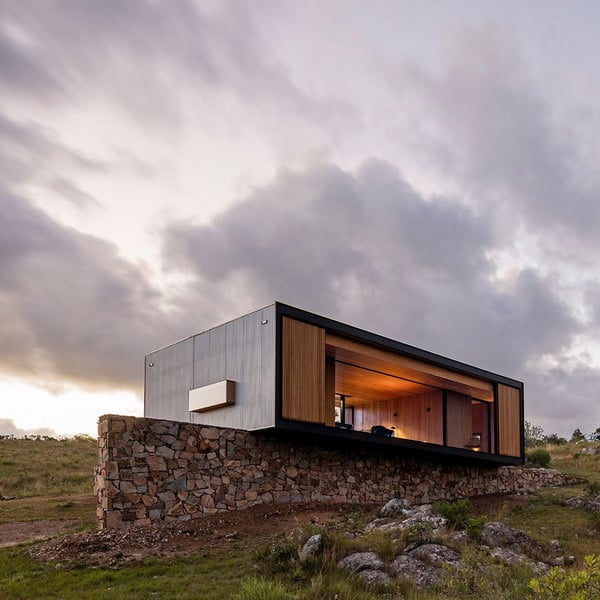
Summing up, we recall those features of the projects implemented and proposed for construction that were repeated and attracted attention in 2024, which allows us to talk about them as obvious architectural trends of the past year.
Minimalist interiors
This year, we saw a lot of strict concise interiors – from apartments and separate rooms to huge office rooms – with a predominance of cold-shaded marble, vast concrete and wooden surfaces and plain walls.
Modular homes
This year, prefabricated block houses have ceased to be considered exclusively temporary housing. You can come to this conclusion when you see how many architects and designers are considering using modular construction technologies to quickly build cost-effective, but aesthetically attractive buildings that would last a long time.
Cohabitation
Throughout the year, construction projects aimed at living together and working, tried to change stereotypical views on the home and work environment, offering a common office space for the entire staff and uniting neighbors from separate houses into one – mainly for economic reasons, but also as a rational housing solution, for example, for the elderly.
Tiling
In 2024, the fashion for “tiled” facades was widely spread. A wide range of materials and sizes of the used tiles allows you to get a unique look of buildings.
Charred tree
Around the world, the Japanese wood protection technique Shou Sugi Ban was used to blacken the facade cladding of public buildings, private houses, pavilions and studios, in which the wood is treated with fire.
Extension of existing buildings
This year, architects explored the most unusual ways to expand residential and public buildings, including in major metropolitan cities.
Environmental friendliness
The all-wooden stadium project in England and numerous autonomous energy projects, proposed by Zaha Hadid Architects, take green architecture and green building to new frontiers.
Studios in the courtyard of the house
Among the artists, designers, writers and DIY enthusiasts there was a massive enthusiasm for creating studios in the infield.
Thin Skyscrapers
In 2024, the world’s thinnest skyscraper was built. In New York, the theme of ultra-tall buildings with a small footprint has become so popular that the Museum of Skyscrapers has released a special application that allows you to track the growing number of “slender” towers, many of which are more than 300 m high. The ratio of the width of the building to its height is up to until 1:23.
Carbon fiber
This year, experts called carbon fiber the building tool of the future, arguing that when combined with robots and building automation, this material paves the way for the fourth industrial revolution.
GOOD TO READ: What Are the Latest Architecture Trends in 2024?
New architectural styles
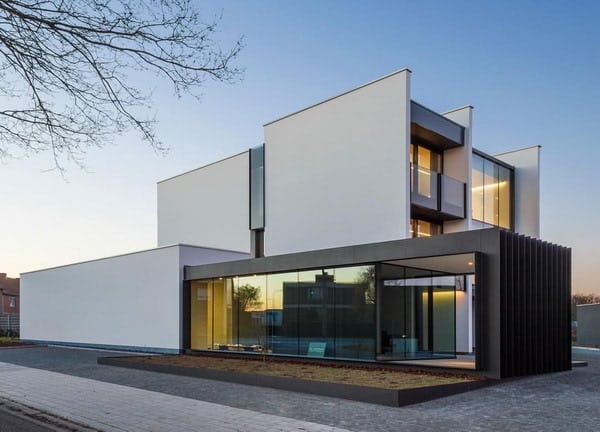 Today, looking at any building, we can determine what architectural style it belongs to and in what century it was built.
Today, looking at any building, we can determine what architectural style it belongs to and in what century it was built.
Since ancient times, people began to build the first dwellings based on the functional needs of the building, its required strength and the availability of building materials. Today, looking at any building, we can understand what architectural style it belongs to and determine the age of construction. Modern architecture represents different types of buildings and some of them are built in a certain style.
Constructivism
Design is one of the methods of shaping, characterized by rigor and geometrism of objects. From this technique, such a style as “constructivism” was born, its second name is functionalism.
Constructivist houses are usually unpainted or gray. This style includes dull identical high-rise buildings built 20 years ago.
It cannot be said that historical houses built in the era of constructivism are now in great demand. The peak of the popularity of these apartments, if we talk about the new time, was in the 90s, when there were no new premium houses on the market. And, in fact, from the old fund, apartments in constructivist buildings were among the best and were in high demand.
Each element of such a building plays its role and occupies a clear position in the composition of space. The windows of buildings can be horizontal or vertical, and the roofs are flat. This style of architecture is often used for the construction of administrative buildings.
Buildings in this style can be erected with a minimum amount of time and construction costs, since there are no unnecessary details and decorative elements.
Over time, it was constructivism that gave rise to popular modern trends such as high-tech, modernism, kitsch, minimalism and organic architecture.
High tech
Hi-tech in translation from English means “high technology”. This style uses the latest modern developments and technologies, representing the desire for comfort and thoughtfulness in everything.
The architectural direction appeared at the end of the 20th century and made it possible to use unusual and futuristic forms in construction. Now high-tech is at the peak of popularity.
Buildings in this style are mostly public, because due to their high cost, only large firms can afford to build such houses. Many business centers are built in this style and consist of glass, plastic and metal.
There are very few real samples of high-tech, these are quite expensive buildings to sell. It is applicable in the construction of special projects. As a style for urban development, it can hardly be effective. Living in high-tech is like living inside an iPhone.
The predominant color of high-tech architecture is silver-metal, and inside the premises of such buildings are spacious and bright. Elements of the building can be taken out and serve as some kind of decoration for the building.
Modernism
The term “modern” means ” new “. The style of “modernism” in architecture appeared at the beginning of our century and means the creation of something completely new. Structures in this style are not distinguished by something exquisite, but rather lack decorations. They are built of concrete or glass, are quite massive and amaze with their originality.
This style of architecture is essentially universal and timeless. Appearing in the 20s of the XX century in close conjunction with constructivism, this phenomenon absorbed several stages of the rapid development of industry and architecture and eventually acquired its high status.
In the construction of such buildings, modern building materials and structures are used. If you look at the building from the outside, we will see a variety of geometric shapes of structures succinctly merged together. Sometimes these forms are completely unconventional and reflect the rich imagination of the architect.
Among the colors of modernism, light pastel or metallic colors usually predominate, which are reminiscent of today’s time of speed, rushing to the future and changing the usual stereotypes.
This style is a mix of art and technology, sophisticated and functional. Every detail of the building is like a play of light and shadow, contrast of form and texture.
Kitsch
Kitsch is a combination of the incompatible, which arose in the 19th century. Literally, the word “kitsch” is translated as bad taste and denies all the canons and previous achievements of art and culture. Kitsch was born out of a love of outrageousness and excessive satiety.
The purpose of building buildings in this style is to attract attention. The exterior finish is like a random mix of all architectural styles in one: it can fit high-tech with modern elements and be complemented by bright rococo stucco.
Kitsch is good as a resounding advertising ploy, but from an architectural point of view it is limited in terms of effective and appropriate use in the urban landscape.
Buildings in the kitsch style can be in the form of objects or products, for example, in the form of a cake or a huge teapot. Outside, every square meter of such a building is filled with something and decorated, it is difficult to pass by such a building and not hold your eyes.
In many ways, architecture determines which house you want to return to and which you don’t. Ultimately, the attractiveness for a potential buyer, and hence the price, of a square meter depends on the talent of the architect.
The color scheme of kitsch buildings is avant-garde, flashy, full of different colors and completely random.
Minimalism
Minimalism is the calmest style of architecture, its principle: “less is more”. Leave the best and most necessary, limit yourself to the smallest, but pay attention to the quality of the building material.
Minimalism cannot always be called a certain style, it is a trend and direction in architecture that arose in the XX-XXI centuries.
This style is characterized by simplicity and elegance, conciseness of structures and forms. Geometric shapes: circles, rectangles and straight lines are typical in the construction of buildings in the style of minimalism. This direction is characterized by simplicity of forms and high functionality. Minimalist architecture eschews decor and decoration and favors natural textures.
The colors of minimasm are the minimum number of shades, the colors of the natural range and most often light. An important element of a building in this style is its lighting, as it gives a certain play of the structure of the building with light. Minimalist materials are most often natural – marble, wood, glass, stone.
Organic architecture
The term organic architecture was first formulated in the 20th century. Organic architecture uses the properties of natural materials and their harmonious placement relative to the environment to create architectural structures.
A distinctive feature of this style is a continuous dialogue with nature, as the building is always inscribed in the landscape. Organic structures are always unique and do not resemble each other. Instead of an architect, the shape of the building, the materials used, the color and texture are dictated by nature itself, its topography and surroundings. The more heterogeneous the terrain and the more slopes it has, the more interesting the building will be.
Modern architects who create housing that is focused on people with high purchasing power use the most expensive technologies and materials so that their buildings are somehow different from others.
Another of the principles of organic architecture is the desire for simplicity of geometric shapes and facades; an overabundance of decorative elements and an excess of color are completely inappropriate here.
Organic architecture itself is kitsch. In my opinion, it is very irrational and, unfortunately, today it is not backed up by technology in any way.
Buildings in this style of stone, brick or concrete are not masked by other finishing materials, their exposure creates a natural decorative effect.
Modern architecture is characterized by freedom of ideas and solutions. Currently, it cannot find certain priority areas. All styles of architecture develop in parallel and find their adherents. The main feature of recent years is the rejection of old styles, the mixing of styles and the search for new images and materials.
New architecture trends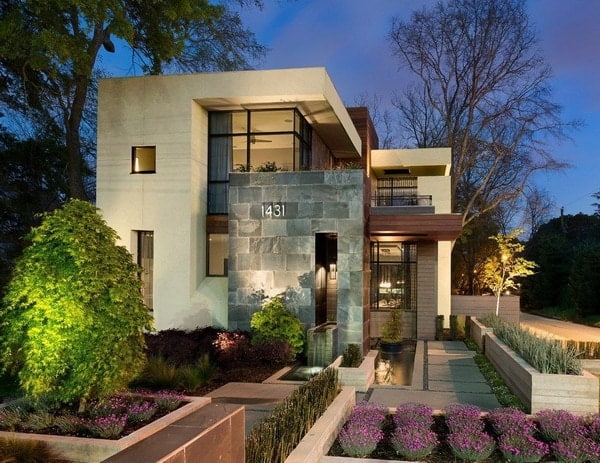
Whether in intimate spaces like our home or in public urban spaces, the environment around us has a major impact on our well-being. The last turbulent years have greatly changed our views on what we expect from the built environment in terms of functionality, appearance and sustainability.
There has been a tremendous shift towards more conscious living in the last decade and this is reflected in the new architecture trends 2024.
Concerns about the overuse of plastics in our environment or how to reduce CO2 emissions from the construction sector are widespread and are influencing our thinking about the built environment.
Here are the biggest architectural trends that we’ll be seeing more of over the next year.
Sustainability remains a focus
Green architecture and environmentally conscious living are architectural trends that will prevail. Considering the state of the world, sustainable solutions and natural or recycled materials are the only options for the future.
Great architecture is no longer just about how a building looks, but also about how it’s built, how efficiently it works, and what becomes of it when it’s no longer needed.
Carbon neutral buildings are good, but we need to go one step further and make our environment climate positive. Think about how to use natural wood, employ water recycling systems and make the most of light, wind and other natural resources.
Timber construction becomes mainstream
The construction industry is still responsible for a large part of the world’s CO2 emissions and this needs to change quickly. Therefore, there is a strong trend in architecture to use wood not only for cladding but also for the construction of buildings.
Many architects opt for all-wood construction because wood is less carbon-intensive compared to other building materials. Wood also offers the opportunity to create prefabricated or modular structures that can be assembled on site but make the construction process faster, smoother, cheaper and more environmentally friendly.
Architecture for the senses
A room must appeal to all the senses. Texture, smells and sounds have a strong impact on how a person feels in certain spaces and urban environments. The easiest way to create this good feeling is to use wood, as it fulfills many properties at once.
The natural texture and color of wood gives a feeling of warmth and comfort. It has good tactile qualities, especially when choosing brushed wood or combined profiles to create a 3D effect on an otherwise flat surface.
Wood also has a pleasant smell when used in large quantities. Not to mention the acoustic benefits that wood brings.
Indoor and outdoor
We are discovering more and more architecture that is based on natural light and other biophilic design elements. Exteriors and interiors are becoming ever more seamlessly connected and intertwined.
To achieve the indoor/outdoor feel, many architects blur the lines by using the same materials in both spaces, particularly wood to bring more natural finishes into the mix.
Smaller, smarter houses
The tiny house movement has been around for a long time, but living in an area smaller than 41 square meters isn’t for everyone. But with the rising cost of living and construction, many are moving toward smaller or at least more energy-efficient homes.
In the future there will be more buildings that meet the passive house standard and have a smaller ecological footprint.
Trends in residential architecture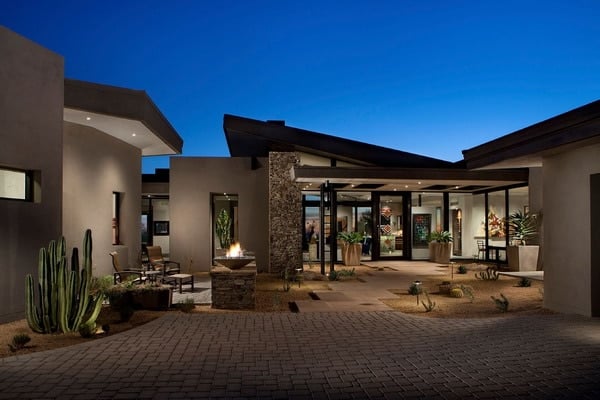
Modern trends in residential architecture are constantly changing. Now more and more unique, innovative complexes appear on the real estate market, which correspond to trends and technologies. Read about the trends in the new article.
In recent years, the approach has changed – serious architects are involved in mass projects, solutions are implemented that are typical for more expensive real estate segments. In Russia, they didn’t come up with anything new, but followed the path of the USA and Europe: architectural bureaus with a worldwide reputation, such as MVRDV, BIG, Herzog & De Meuron, have long been involved in mass housing projects in the West.
Residential complexes are becoming more functional, there are more amenities for potential buyers.
Among the important changes that can already be seen everywhere in residential real estate today are car-free yards, ground-level entrances, thoughtful lobbies filled with functions. The rejuvenation of buyers also influences the changes – young buyers have different needs. For them, for example, care for the environment, the sharing economy, and the rejection of private cars are important.
Also, in modern architecture, already established trends have developed, which over the next two years will have a peak value, as experts explain.
The first is environmental friendliness, both in terms of materials and technologies, and in terms of arranging a residential environment and creating a comfortable space for living. The second trend is the emergence of common areas for receiving guests outside the living space. We are talking about couriers, delivery services or guests to whom you are not ready to give access to your personal space. Thus, the architecture of new residential complexes provides for the arrangement of various reception points and meeting places.
In addition, one of the clear global architectural trends is the growing popularity of “green” roofs.
Green” roofs perform several important functions. Firstly, due to additional green spaces, they help reduce the amount of carbon dioxide in the atmosphere and improve the ecology in cities. Secondly, they help solve the problem of the urban heat island. In addition, this type of roofing helps to reduce the load on urban purification systems – rainwater flows directly into sewer systems, does not collect dirt, oil, gasoline from the streets.
